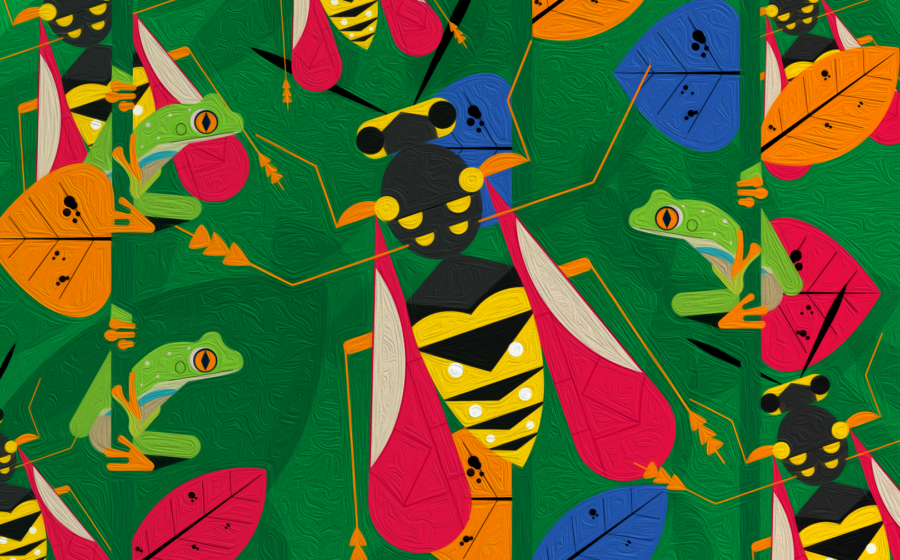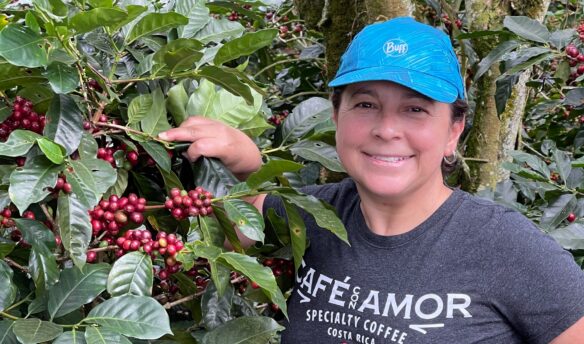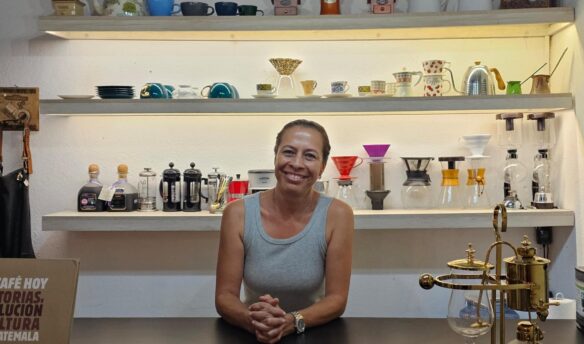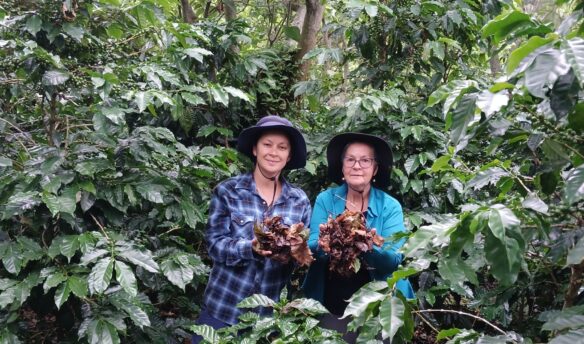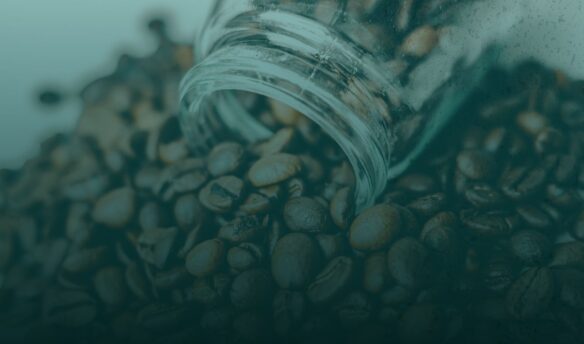Coffee is a fragile plant, and its delicious fruit is attractive not just to humans looking to gain powers of alertness and concentration from its brewed beans. Insects love to feast on the coffee fruits or use them as houses for their offspring, which is good for them but not so good for us. The most infamous coffee pest, the coffee berry borer beetle, causes an estimated $500 million worth of damage to coffee farms every year.
We’re used to hearing why insects and animals are destructive to coffee, from reducing the number of viable coffee plants and cherries on a farm to negatively affecting quality. Researchers have identified over 900 species of insects, not to mention myriad other creatures like nematodes, birds, and snails, that can attack the coffee plant.
But coffee farms are part of larger ecosystems, so what about the good that critters do for coffee? While we condemn pests and eradicate infestations, don’t forget coffee’s animal helpers. From birds that eat invasive insects to insects that pollinate the plants, a whole army of animals live their lives in service to the coffee plant.
Release the Wasps!
During a field research visit in August 2010, a graduate student at the University of Hawaii discovered evidence of Hypothenemus hampei, or the coffee berry borer. The coffee berry borer is a tiny beetle native to Africa that burrows into the coffee cherry to feed on the bean and, if left uncontrolled, can devastate a farm’s coffee harvest. Because it can potentially wipe out an entire farm’s production, coffee berry borers are considered the most damaging insect pests to coffee worldwide.
Although the beetle had already been found on coffee farms across the globe, the graduate student’s findings sparked immediate concern. “She was finding about 90 percent of the trees in the field she was doing her research in were infested,” Neil Reimer, an entomologist, told KHON 2 News at the time. The researcher initially witnessed evidence of the invasive species in Kona on the Big Island of Hawaii, but over the next decade, the coffee berry borer spread to Oahu, Maui, and Kauai.
The United States government has spent millions fighting coffee berry borers, including the USDA, which invested over a million dollars to help quell outbreaks—yet borers still plague farms across the state. Over the last decade, farmers have been encouraged to try dozens of different methods to eradicate the beetles, including using insecticides and specific fungus applications to control spread.
We found that the wasps will only attack coffee berry borer and its very closest relatives—which are all invasive in Hawaii already—such as tropical nut borer, a pest of macadamia. Mark Wright, University of hawaii at manoa
But recently, researchers have proposed another solution. Scientists at the University of Hawaii plan to unleash Phymastichus coffea onto farms in the area. Phymastichus coffea is a microscopic wasp also native to Africa and happens to be a natural predator of coffee berry borer beetles. Scientists spent years studying the wasps, attempting to determine if releasing them would harm other plants or animals, and now they’re getting ready to perform their first field tests.
“We conducted extensive quarantine tests on the wasps, exposing as many native beetle species as possible to them, as well as other invasive beetles,” says Mark Wright, a professor of entomology at the University of Hawaii at Manoa. “We found that the wasps will only attack coffee berry borer and its very closest relatives—which are all invasive in Hawaii already—such as tropical nut borer, a pest of macadamia.”
Researchers at Colombia’s National Coffee Research Center (Cenicafé) have already conducted field tests with P. coffea and will supply the team in Hawaii with its first shipment of the potentially farm-saving wasps. After more testing, Wright and his team will begin field trials, but the potential of the wasps to eradicate coffee berry borers is already sparking excitement across the state. “Farmers are enthusiastic to get the wasps out into the field,” says Wright.
‘It’s an Ecosystem’
When Ana Vizcaino first inherited Finca Esperanza in 2009, it was a standard conventional coffee farm. Although her father, from whom she had inherited the farm in the Suchitepéquez department of Guatemala, didn’t use pesticides, he did use herbicides to manage weeds and other plant pests. She quickly noticed that the environment felt out of balance.
We have more frogs and lizards, and everything is … working now. We still have spiders, but they are not out of control—they have found a balance. It’s an ecosystem. Ana Vizcaino, finca esperanza
“There was no control,” Vizcaino says. “For example, we had so many spiders that you had to go through the coffee plants with a broom to make like cotton candy from the webs. It was not balanced.” So she began working to turn the farm fully organic and restore the diversity of plant and animal life. “With the years, it has become better. We have more frogs and lizards, and everything is kind of working now. We still have spiders, but they are not out of control—they have found a balance. It’s an ecosystem.”
Today, Vizcaino’s farm is home to all sorts of wildlife, from bees to frogs to migratory birds. She is especially enthusiastic about amphibians, who she credits with suppressing the mosquitos on her farm and reducing instances of dengue fever among her workers. She’s added an apiary, which helps the farm in numerous ways: multiple studies have shown that bees and other pollinators can increase fruit set (the ability for a flower to turn into a berry), cherry size, and yield. Vizcaino also collects honey from her bees, which she shares with her workers.
The work of maintaining an organic farm is never done. Coffee berry borers have also been found in Guatemala, and this year, Vizcaino experimented with the P. coffea wasps to supplement her other control methods. “I was very skeptical about doing it just because sometimes you disrupt the ecosystem of the region,” she says. “But we already disrupted it just by having coffee, and all the studies I have read said that [the wasps] cannot survive unless they have the borer, so I feel pretty confident they’re not going to attack any other insects.”
Improving Human and Plant Health
There are so many animals beneficial to coffee farms that it would be impossible to detail them all (although shout out to the invasive snail that switched its diet to consume coffee leaf rust and could play a role in the future of controlling the devastating disease, which slowly kills coffee plants and is considered one of the other main threats to coffee production worldwide).
When natural processes are affected, the crop depends on artificial processes such as chemicals. All this can be further complicated in cases where pests become resistant to insecticides. In the long term, chemicals pollute the environment, affect human health, and increase production costs. Dr. Juan Francisco Barrera Gaytán
But how can producers make farms homier for beneficial insects? The key is to cut back on chemicals, says entomologist Juan Francisco Barrera Gaytán from El Colegio de la Frontera Sur in Tapachula, Mexico. Spraying chemicals like insecticide, Dr. Barrera explains, creates a vicious cycle where farmers need ever more chemicals because they kill all the beneficial insects along with the pests.
“When natural processes are affected, the crop depends on artificial processes such as chemicals,” Dr. Barrera says. “All this can be further complicated in cases where pests become resistant to insecticides. In the long term, chemicals pollute the environment, affect human health, and increase production costs.”
We shouldn’t underestimate the effects of farm-based chemicals on human health: one study from 2023 linked pesticide use to instances of skin disorders, cardiovascular disease, and cancer among coffee farm workers. That study suggested using biological controls like insect predators to control pests, which Dr. Barrera agrees with. “Reducing or avoiding the use of chemicals through conservation biological control and other agro-ecological techniques helps reduce pest predator mortality,” he says. “In addition, the contamination of water, soil, and air with these products is reduced, and the health of farm workers is improved.”
As the planet heats and climate change continues to threaten the planet, pests and diseases are becoming ever more prevalent on coffee farms. Figuring out new techniques to safely control and prevent these threats is vital to ensure coffee’s long-term future. From encouraging regenerative agriculture to experimenting with pest predators, it seems like coffee critters will continue to play a critical role.



